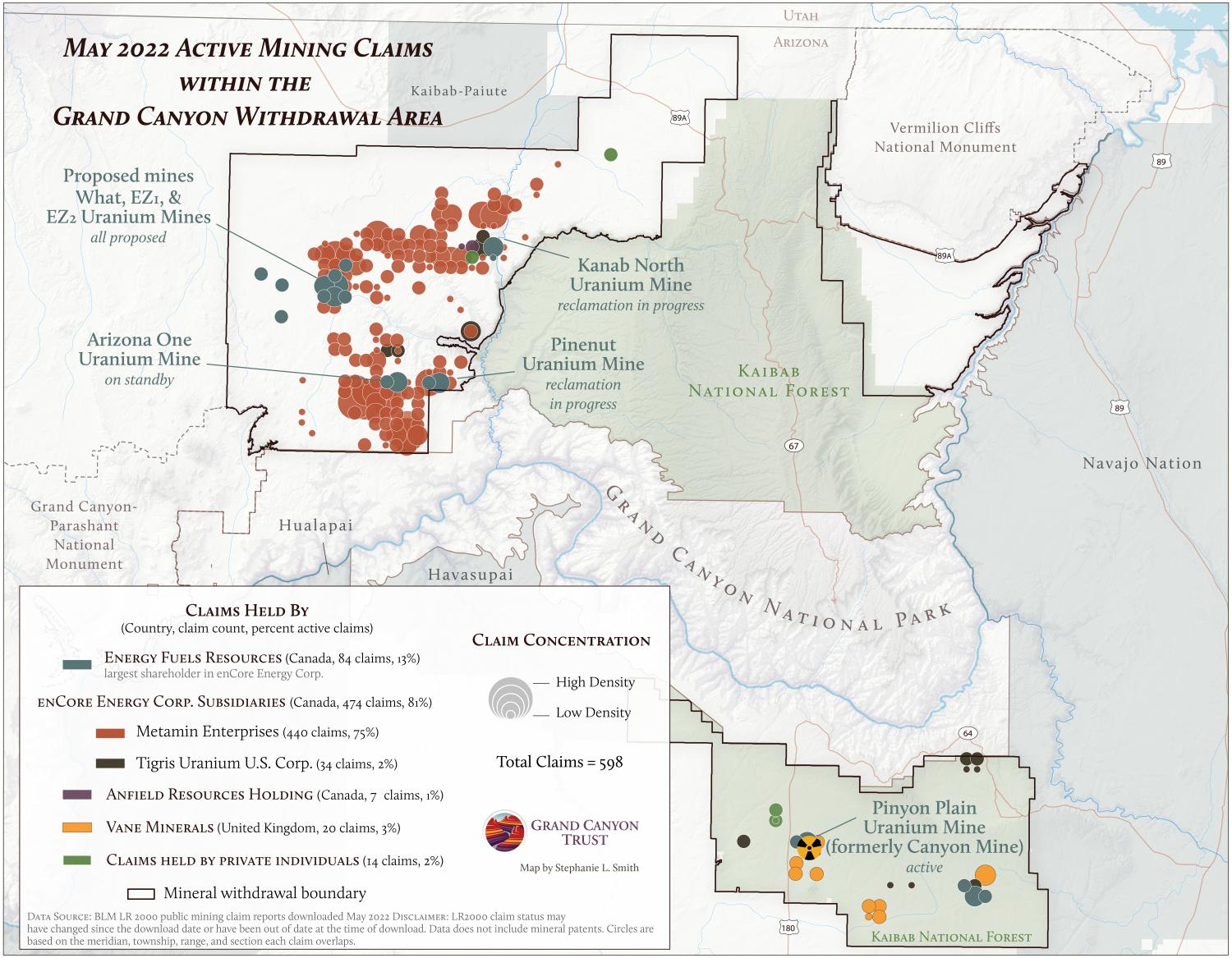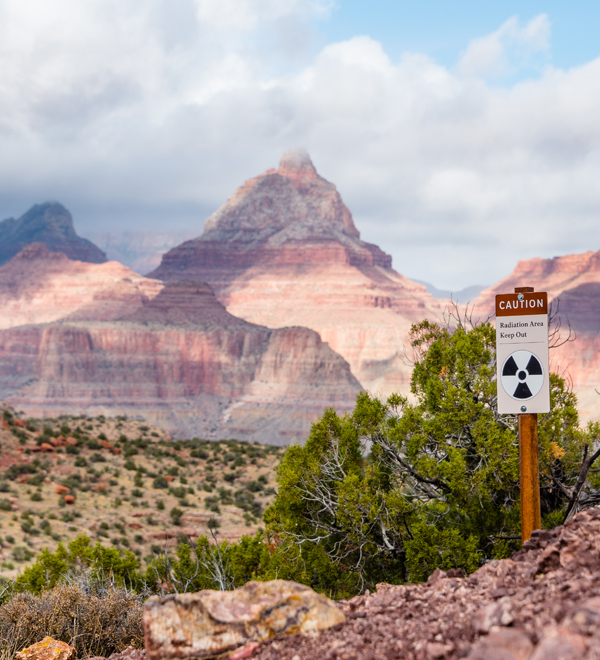FOR IMMEDIATE RELEASE
GRAND CANYON NATIONAL PARK, AZ – The Pinyon Plain Mine (formerly Canyon Mine) appears to be gearing up for uranium mining operations fewer than 10 miles from the south rim of the Grand Canyon. Hundreds more uranium mines could eventually be developed on federal public lands near Grand Canyon National Park if the Senate fails to pass Senate Bill 387, the Grand Canyon Protection Act.
Operators of the controversial uranium mine recently posted a job ad on Craigslist to recruit new miners, after its owner announced a deal that could ramp up operations at the mine as soon as 2023. Increased activity has been observed inside the mine fence.
The Senate has only a few weeks left to pass the Grand Canyon Protection Act, which would permanently ban new uranium mines on just over 1 million acres of federal public lands. The bill has already passed the house twice.
As longtime residents of the Grand Canyon, the Havasupai Tribe, its leaders, and elders, have fought against uranium mining for decades.
"It is time to permanently ban uranium mining — not only to preserve the Havasupai Tribe’s cultural identity and our existence as the Havasupai People, but to protect the Grand Canyon for generations to come," said Chairman Thomas Siyuja, Sr. "With recent activity observed inside the mine fence, it is clear that the mining company is making plans to begin its operations."
According to Chairman Siyuja, Sr., "The Havasupai Tribe knows the irreparable damage that uranium mining can do. For generations, we have been at the forefront working to permanently protect our ancient homelands from the negative impacts of uranium mining, which has disproportionately harmed and sickened indigenous people across Northern Arizona. The Senate must pass the Grand Canyon Protection Act and once and for all permanently ban any new uranium mines on our ancestral lands."
There are nearly 600 active mining claims staked near Grand Canyon National Park. If the Senate fails to act, those claims could be developed into mines if the existing temporary mining ban is lifted or expires.

Uranium mining has a long history of contaminating land and water and sickening people in the region, including on the nearby Navajo Nation, where hundreds of abandoned uranium mines still await cleanup. At Pinyon Plain Mine alone, more than 49 millions gallons of groundwater contaminated with high levels of uranium and arsenic have been pumped out of the mine shaft.
"Pinyon Plain Mine remains a shameful example of why the Grand Canyon region must be permanently protected from further mining," said Amber Reimondo, energy director for the Grand Canyon Trust. "For over 30 years, the Havasupai Tribe has been clear about the harm this mine causes. Yet regulators still focus only on when and how to allow it, rather than whether this uranium mine should be allowed at all."
"The fact that Pinyon Plain Mine is just a few miles away from the Arizona National Scenic Trail is alarming," said Matthew Nelson, executive director of the Arizona Trail Association. "In the interest of public safety, and for the love of clean air and water and soil for people and wildlife, we urge decision makers to reconsider the permitting for this mine and ban new mines here in the future. The risks far outweigh the rewards."
"Canyon Mine, now renamed as Pinyon Plain, should have never been allowed to go forward by the Forest Service, by the Arizona Department of Environmental Quality, and other agencies that have permitted it," said Sandy Bahr, chapter director for Sierra Club’s Grand Canyon Chapter. "It is a serious threat to the waters and people of Grand Canyon and demonstrates that we need stronger protections for these public lands surrounding Grand Canyon. We stand in solidarity with the Havasupai against this mine and in support of the Grand Canyon Protection Act."
"Federal and state officials have exposed Grand Canyon’s aquifers and springs to threats of permanent, irretrievable damage by approving the Pinyon Plain uranium mine," said Taylor McKinnon of the Center for Biological Diversity. "Those risks are unacceptable and those approvals should be withdrawn. Congress must act now to permanently protect the Grand Canyon region from the devastation of more uranium mining."
"History and science are clear. Uranium mining will devastate the Grand Canyon and recklessly poison the water and land of the Havasupai people," said Earthjustice Senior Legislative Representative Blaine Miller-McFeeley. "Instead of safeguarding the profits of a mining company, we must urgently pass the Grand Canyon Protection Act to permanently protect this iconic site, its natural resources, and the people who call it home for generations to come. The House has already acted, and it’s time for the Senate to put the interests of the people over polluting industries and pass this legislation."
"The clock is ticking for Congress to come together to protect the irreplaceable Grand Canyon watershed landscape and the entire water supply of the Havasupai people from industrial mining threats," said Michè Lozano, Arizona program manager for the National Parks Conservation Association. "Passing this commonsense legislation is essential to prevent the incredible threats that uranium mining poses to the canyon’s limited water sources that feed its creeks and waterways."
"It doesn’t matter what you call a uranium mine that transgresses the seeps, springs, and aquifers that supply water to the people, plants, and animals of the Grand Canyon; to protect them, the tragic legacy of uranium mining must not be repeated," said David Spence, MD, board president of the Arizona Chapter of Physicians for Social Responsibility. "Only Congress can protect against the future development of uranium mining in this sensitive region."
"Pinyon Plain (Canyon) Mine operations already clearly demonstrate that major harmful impacts to both groundwater supply and water quality cannot be avoided when mining uranium near Grand Canyon,” said Kelly Burke, executive director of Wild Arizona. "This is why state and federal officials, as well as Congress, must listen to the Havasupai and take immediate, life-affirming action leading to mine closure and passage of the Grand Canyon Protection Act."
Photos
Photos free for media use are available here with caption and credit information. Download photos and caption info ›
Background
Pinyon Plain Mine, also known as Canyon Mine, is located in a meadow on the Kaibab National Forest, near Red Butte, a federally recognized traditional cultural property, south of Grand Canyon National Park. The area is the aboriginal homeland of the Havasupai Tribe and the mine threatens the Tribe’s only source of drinking water. The Havasupai Tribe has led opposition to the mine since it was first approved in the 1980s. While passage of the Grand Canyon Protection Act would stop new mines from being developed, it would not shut down existing mines like Pinyon Plain Mine. The Havasupai Tribe and its many supporters remain committed to seeing the mine closed and cleaned up.

